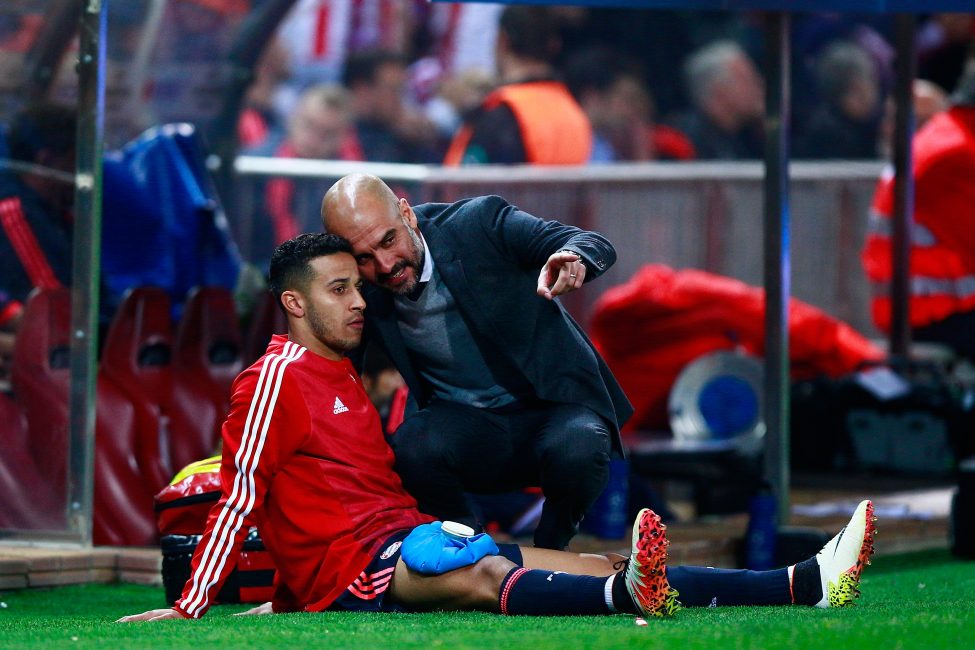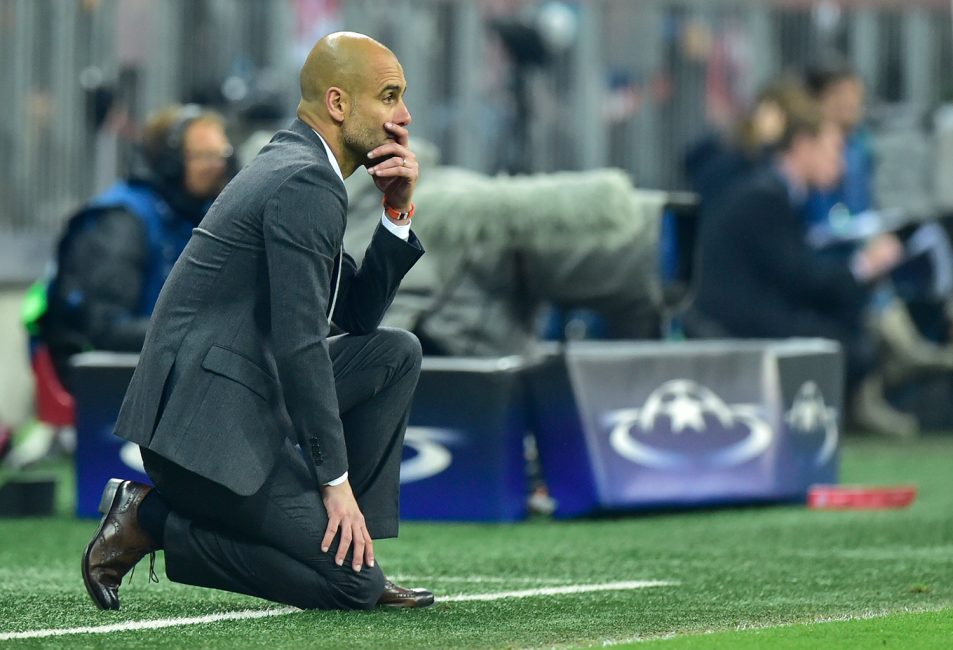Talking About A Revolution: Guardiola at FC Bayern
Colleague Marco Henseling spoke with Spox in the summer of 2012 of postmodernism; Klaus Bartels already did so in the ZEIT in 1986. In 2010 even Christoph Biermann, one of the most important German football writers of our time, hit the same note in the TAZ. Basically, postmodernism is merely a belief, in this context, it refers to a use of old ideas in a new guise in football instead of an innovation opportunity.
But what has Guardiola to do with this? As innovations are rare, Arrigo Sacchi’s reduction of space in the late ’80s – in Germany propagated by Helmut Groß and his followers – is considered probably the last real innovation. But Guardiola and his most important influence – Juanma Lillo – also had something to offer with their fusion of offense and defense, their use of an organized positional play, and their specific use of possession.
Since then, world football has changed. If you watch ten year old matches today, the difference to the current state of play is dramatic, but ten year old games only look marginally different to the games that were played thirty years ago. Today, the game with the ball is structured, the pace is tremendous – not least because the style of aggressive pressing of Guardiola’s Barcelona was quickly copied and used by other teams around Europe. Germany especially stands out, where Klopp claimed to be very influenced by Sacchi.
What does Pep still have in store? He has not come up with any major strategic innovation lately. Many desired him to repeat his achievements in strategically innovating football at Barcelona when the Catalan moved to Bayern. It didn’t happen; which is not surprising. In tactical aspects, the future ex-Bayern coach continues to be one, if not the best in his field. This is what he impressively demonstrated in his three years in Munich.
Year 1: The search for a common identity
When Guardiola took office, there was an unprecedented hype. His press conference and the first training session were staged in a way never seen before in Germany. At the same time it was an impetus for tactical contemplations at an unprecedented level. What would Guardiola change at the treble-winner? Should he even change anything? In trying to answer these questions, the blogosphere engaged in long reflections on what Guardiola stands for and what differentiated him from Heynckes. The mainstream media supported this discussion with important information about Guardiola’s plans, for example the news after the first training that the new coach would like to use Franck Ribery in the middle.
But Guardiola met with some obstacles. The other teams in Germany made for strategically rather unpleasant opponents with their unparalleled focus on pressing and transitional play. Although some Bundesliga teams lacked and still lack high-class structure in possession and some aspects of classic defensive play when compared to Spanish teams, they are at least as good in pressing and using counterattacks. In addition, players like Ribéry were not completely convinced of the new playing positions Guardiola had in mind for them.
In the first season, a certain disquiet arose around Munich. How much was it acceptable for Guardiola to deviate from the Heynckes’ football? He managed to establish the basic principles of positional play quickly thanks to his exceptional quality on the training pitch, but his team still lacked some of the more intricate features of play that are so hard to learn. The quality of Robben’s and Ribéry’s runs varied between “unclean in positional play” and “too static”. Mandzukic as the spearhead in attack was able to open up more spaces than during the Heynckes era, but his linkup play was poor and his space opening movements were less valuable due to Guardiola’s system. In the centre, Guardiola had players who were strong on the ball, but Kroos and particularly Schweinsteiger were not as intuitive a team as Xavi and Iniesta at Barcelona in terms of their rhythm in passing and behaviour on the ball. Kroos quickly adapted, but with Schweinsteiger Guardiola kept having troubles.

(Bild: Gonzalo Arroyo Moreno / Getty Images)
Guardiola’s key transfer Thiago Alcantara, just like Mario Götze, repeatedly suffered from injuries. Highlights where the two could shine together, such as against BVB in the first meeting in the Bundesliga, were unfortunately a rarity. During the season, Guardiola found solutions to the problems in hand. On the one hand, he made opponent specific adjustments from one game to the next, which mostly proved to be of very good judgement and ensured the earliest championship in Bundesliga history. On the other hand, he made fundamental changes within the system. Especially three measures emerged:
- Lahm as a number six
- Inverted full-backs
- Changed winger roles
Guardiola considered his decision to put Lahm on the six his most important move of the season. The captain of the German world cup champion stands out for his enormous game intelligence, his strategic skills and his pressing resistance. He brought decisive strengths to the entire structure of Bayern on and against the ball.
The inverted full-backs were primarily used when Lahm did not play in the middle. In this case, Guardiola tended to use Lahm and Alaba centrally, which moved the number eights higher and allowed the wingers to give width. Kroos on the number six was the most common complement in the centre of the pitch in this constellation.
This went hand in hand with the mentioned changes of the winger roles. Bayern’s passing rhythm was wing oriented and breakthroughs were created with wide dribbles, crosses, through balls in the half spaces and fast combinations with the advanced number eights. Bayern ultimately failed against Real Madrid in the second leg of the CL semi-final because of the issues that were visible at the beginning of the season: Lack of balance in defensive coverage, problems in the centre of the pitch, sloppiness in the last third.
This adjustment was a hint to the future development of Bayern.
Year 2: Working on the details in the system
In 2014/15, the identity that should describe Bayern in the next two years, was identifiable early. Their transfers were an early suggestion of this. Bernat as a new full-back, Xabi Alonso on the six, Rode as an alternative in midfield and Lewandowski up front were evidence of a new and clearer focus.
Lewandowski was no “false nine”, no striker type such as Karim Benzema, rather similar to Mandzukic, but with massively better skills with the ball at his feet. He should provide the opportunity to continue to play long balls, to be able to use crosses into the centre or to act as a lay-off option for the wingers. Alonso was basically a substitute for the transferred Kroos, but the Spaniard was different from the German international in several important respects. Alonso was a stronger sole number six and able to play tremendously accurate long diagonal balls. He was a perfect complement in this regard for the new system. Rode brought more dynamic, physical presence and verticality to the center of midfield, Bernat became an alternative to Alaba.
Alaba was in fact an important aspect in this second year. Guardiola continued to experiment with his system after the German Cup final against Dortmund, where he used a back three for the first time in a competitive match. Repeatedly in 2014/15, he played with 3-4-3 / 3-4-2-1 systems. For Guardiola it is seemed to be important to find out exactly how he should use the wings.
Some games featured a winger (Robben) and a full-back (Bernat) on the sides. In other games two full-backs were used or the team returned to a 4-3-3, which was however interpreted often like a 4-4-2. Against the ball Müller often played deeper, and in possession high in the central spaces next to Lewandowski. A couple of times, Guardiola even used a 4-3-1-2 / 4-1-3-2 – a midfield diamond – with Robben, Ribery and Götze together in front of Alonso and behind two strikers (Hertha, Hoffenheim).
This phase saw some great games. In addition to the epic victory against Roma with Robben as a wing back, Alaba’s usage repeatedly caught the eye when he marched as a half-back forward and took a key role in this system. Alonso as a number six in front of a back three also worked better. The combination of Alonso and Schweinsteiger as a double number six still did not work properly. However, the increased focus on the wingers became a double-edged sword: Ribéry and Robben were repeatedly absent, and in the decisive phase of the season in spring, even both of them were often missing.
Although this could be compensated by Bayern’s outstanding quality against the ball, high individual class and some other factors like a few enhanced counter-oriented games and a focus on crosses for Müller and Lewandowski, change was needed for the next season. This change came mainly in form of new players as Guardiola decided to alter the personnel rather than the system.
In the final Guardiola-year the experiments decreased. Although there were, of course, always the specific adjustments to the opponent, these varied more in detail and not in the team tactics.
Year 3: A nearly successful finish
Three in the back and related concepts were occasionally used again, but by spring the 4-1-4-1 / 4-3-3 had become standard with only modest modifications. This was possible because with Coman and Costa two new wingers were brought in in the summer. The winger positions now had back-ups.
Costa and Coman basically offered like-for-like replacements for Ribéry and Robben, but both can also play on the opposite side and break through to the baseline to create crosses. The combination of two basic concepts – the focus on the centre-forward and the focus on the winger – was created. When Ribery and Robben were unavailable, the system could be maintained – with dribblings by the wingers towards the centre – or changed or interpreted asymmetrically when only one of Robben / Ribery was fit. If necessary, Götze and Müller could start on the wing, this requirement was, however, hardly necessary.
Another transfer also emerged as an important aspect in this variable 4-1-4-1 with asymmetrical midfielders. Vidal as another option in the middle even managed to side-line Guardiola’s favourite player. Thiago alternated between starting XI and the bench, even when he was fit. Initially, the newly purchased Chilean from Juventus Turin had his problems. He did not bring a new element to Bayern’s build-up play and in attack, he hindered the effectiveness of his team’s combinational play. Only when Guardiola increasingly used Vidal as an advancing player, his special strengths (threat on goal, verticality in the game off the ball, lurking in the back of the box, counter pressing) were integrated into the system.
For the crowning achievement – another Triple – it was not enough. Nevertheless, Guardiola and his players seem to rate the “project” as a success going by their recent statements. They are not wrong. Football is a game with an enormous amount of chance in it. Half the time you’re unlucky, half the time the other team has luck.
Final discussion: Mia san Mia was met
Of course, Guardiola is not above criticism. Considering the many injuries his players have suffered, his training management could not always have been optimal, although this of course cannot be attributed to Guardiola alone. The integration of Götze could have been more effective, as well as dealing with the media and individual decisions in certain games where tactical errors were made.
The question remains, however, whether someone else could have done better. No coach is able to constantly prepare and set up his team. This is simply impossible. In contrast to many others, however, Guardiola is brave enough to make changes to successful line-ups to increase the probability of success in specific games. That makes him vulnerable. Although it should not be the fault itself, but the lack of courage to make mistakes that gets the greater criticism.
Guardiola can be viewed as a kind of project manager. His objectives were to establish a new – his – playing style at Bayern and make it popular in Germany at the same time. He has reached these goals. The “Mia san Mia” was not shelved, but expanded. Bayern’s dominance came through in every game, they won the championship early in the season every year, and despite the difficult task to repeatedly meet these high expectations amidst a resurgent Dortmund and a constant two games a week schedule, they performed with unprecedented sovereignty.

(Bild: JOHN MACDOUGALL / AFP / Getty Images)
The project manager Guardiola could be defined as following: Concept phase (before taking office), the definition phase (year 1), design and development (end of year 1 to start year 3), operation and maintenance phase (year 3), sun-down phase (last months of year 3). Statistical values like expected goals, which are less dependent on individual results than the actual final score, show that Guardiola’s team does not have to hide compared to the treble-winning team of 2013 or Guardiola’s Barcelona in this regard.
Of course, due to some individual errors and the failure to win a CL title, a stain will remain on the white vest. But Guardiola has achieved that the discussion about football has been raised to a new level. Some parts of the mainstream media are still reserved, but the blogosphere and some journalists have largely gone along. And discussions with coaches in the professional, amateur, and youth sector show how Guardiola is seen as a role model. Jogi Löw’s national team also incorporates some of his ideas, just like young or lesser-known coaches from lower levels, like Horst Steffen (formerly Stuttgarter Kickers, now Preußen Münster) or Sandro Schwarz (Mainz II). The spurt of development that Rangnick’s and Klopp’s football initiated at the end of the 2000s could repeat itself in the next few years thanks to Guardiola – or so you might wish.












Is there a German version of this article, too? Can’t find find it on miasanrot.de. But this translation is not very good. German syntax does not belong in an English text, it makes it difficult to read.
Feedback is always welcome. If you tell me where I messed up, I’ll fix it.
Some small translation problems but in principle a very good analysis.
Pep’s star will continue as he heads off to work with the richest club in the World who are desperate to create their own European success.